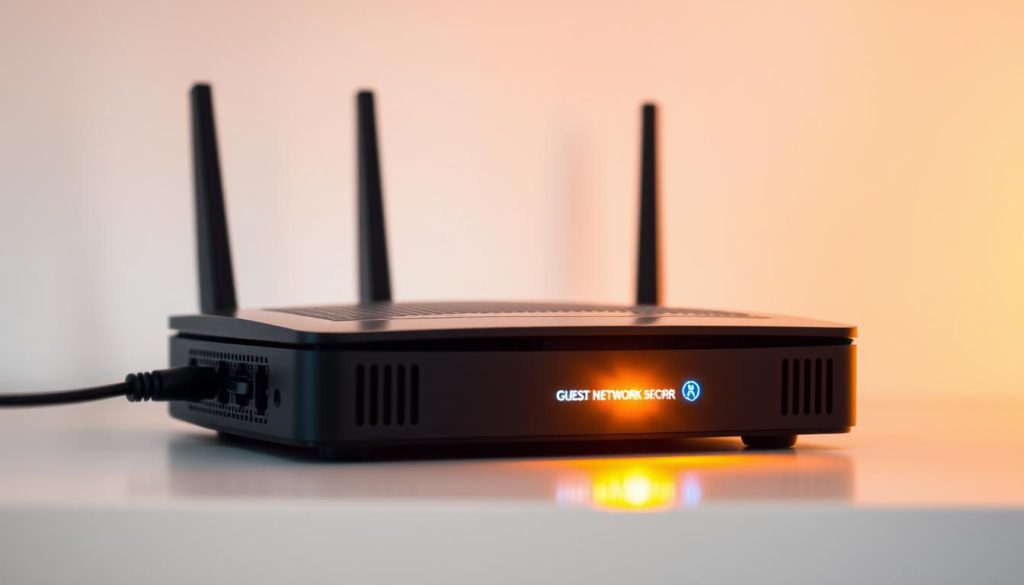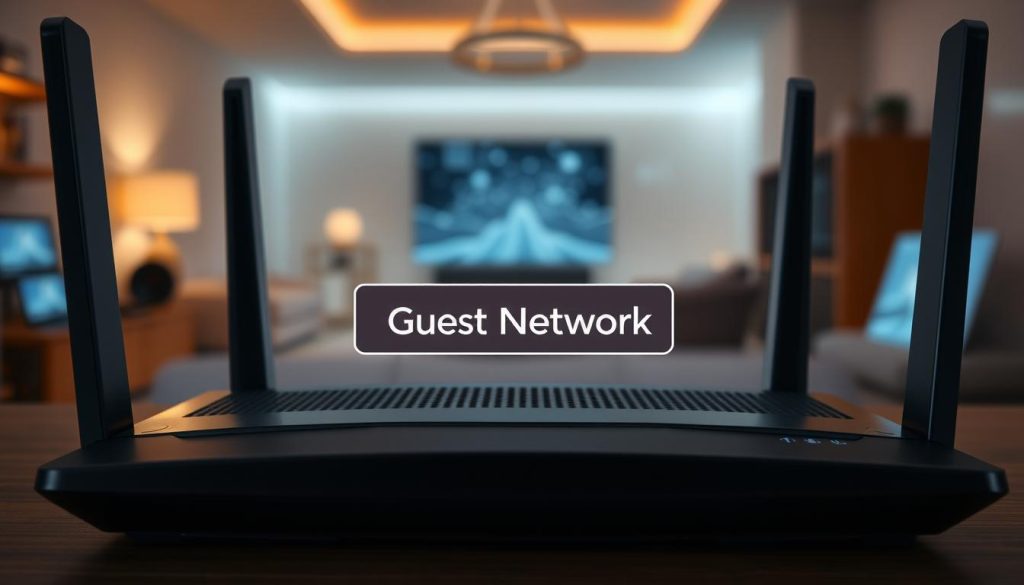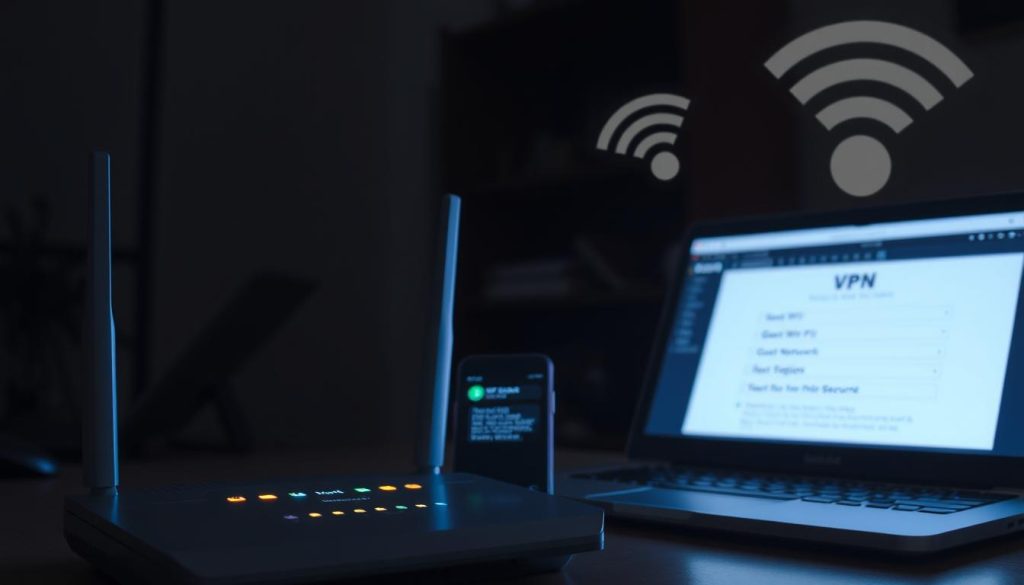Sharing a wireless link with visitors sounds handy, but it can introduce real risks when setup is incomplete.
A guest Wi‑Fi layer usually runs as a separate subnet on the same hardware to keep common devices apart. If isolation, encryption (WPA3 or WPA2‑AES), and admin settings are weak, unintended access can cross boundaries and expose personal data.
This short guide explains how a typical network setup can fail, what misconfigurations let threats move between zones, and which router panel controls you should check first. You will see how segmentation and device isolation are supposed to work, and which quick fixes restore stronger security at home.
Key Takeaways
- Enable proper isolation and choose WPA3 or WPA2‑AES for stronger encryption.
- Verify that the guest -fi segment cannot reach LAN devices like printers or NAS.
- Limit guest bandwidth and monitor connected clients to preserve performance.
- Consider a router‑level VPN to shield guest browsing and reduce eavesdropping risks.
- Segment IoT gadgets away from main systems and keep firmware updated regularly.
Understanding Guest Wi‑Fi: What It Is and How It’s Supposed to Protect You
Separating traffic into a second subnet gives guests internet access while shielding shared files and printers. A guest wi‑fi network is a secondary network on the same router that assigns visitors to a distinct subnet. This keeps household machines and stored information out of reach.
Network segmentation means guests get IP addresses from a different range than the main wi‑fi network. That logical split prevents casual probing of printers, NAS boxes, and personal computers.
Device isolation (often AP or Client Isolation) blocks peer‑to‑peer chatter between visitor phones and laptops. That stops one infected device from scanning or infecting another on the same guest -fi network.
- Many routers deliver both features inside one physical unit, so settings matter.
- Use a unique SSID and strong encryption to keep unauthorized users out.
- Disable any option labeled “Allow guests to access my local network” to enforce separation.
Combined, a separate subnet plus device isolation forms the basic security model for safe guest access, including short‑term hosting scenarios like Airbnb.
Why Your Router’s Guest Network Might Still Leak Private Data
Academic tests have exposed how logical separations on consumer equipment can be pierced by crafted traffic. Researchers at Ben‑Gurion University presented work at the USENIX Workshop on Offensive Technologies showing that many consumer routers allow covert channels between segments.
Cross‑network communication risks are real even when a device advertises separate SSIDs. The team demonstrated crafted packets that can tunnel commands or siphon information across isolated ranges on the same hardware.
How crafted packets can bypass logical separation
Attackers can combine small packet tricks to create covert channels. Those channels may control implants or exfiltrate sensitive bits across a split setup.
“Covert channels can bridge logical boundaries on common consumer gear, enabling control and exfiltration across segments.”
When software patches aren’t enough without hardware separation
Some flaws are patchable, but fixes may not remove every residual path. For high‑risk environments, physical segmentation remains the safest option.
For homes, layered defenses raise the cost of exploitation: strict firewall rules, VPN tunnels for guest traffic, and active traffic monitoring reduce exposure.
| Mitigation | Effectiveness | Notes |
|---|---|---|
| Firmware updates | Moderate | Fixes many bugs but may miss architectural channels |
| Strict firewall + VPN | High | Raises difficulty for attackers without new hardware |
| Hardware separation | Very High | Physical isolation guarantees segmentation |
| Monitoring & alerts | Moderate | Detects unusual patterns early |
- Key point: treat software isolation as useful but fallible.
- Decide by risk: strong config works for most homes; hardware split suits regulated contexts.
Real‑World Threats: From Malwarey Guests to Man‑in‑the‑Middle Attacks
A compromised visitor device can act as a stepping stone, probing and attacking nearby devices if isolation fails.
Compromised visitor devices often run background scanners or worms that seek reachable hosts on the same network. If device isolation is off, these tools can attempt logins, push exploits, or move laterally toward printers and NAS boxes.
Without strong encryption, attackers on the same -fi network can sniff unencrypted sessions and harvest credentials or session cookies. Modern HTTPS defends most web traffic, but misconfigured routers and old devices still expose sensitive information.
Practical steps reduce risk: enable WPA3 or WPA2‑AES, keep firmware current, and limit guest access to the internet only. Monitoring connected clients and rate‑limiting internet traffic deters abuse and helps spot intruders fast.
- A compromised phone or laptop may probe other devices if isolation is disabled.
- Attackers can eavesdrop on unencrypted sessions and perform MITM on weak links.
- Firmware updates and strict isolation drastically lower lateral movement risks.
| Threat | Typical impact | Mitigation | Priority |
|---|---|---|---|
| Lateral probing | Device compromise on LAN | Enable device isolation; block LAN access | High |
| Packet sniffing | Credential or token theft | Use WPA3/WPA2‑AES and prefer HTTPS | High |
| MITM via captive portals | Content tampering, login theft | Avoid open SSIDs; require strong auth | Medium |
| Exploit escalation | Router or firmware compromise | Apply firmware updates; monitor clients | High |
“Together, strong encryption, isolation, and basic hygiene make opportunistic attacks far less likely to succeed.”
Quick Diagnostic: Is Your Guest Wi‑Fi Actually Isolated?
Run a short set of checks to confirm that the secondary SSID cannot reach household devices. These tests use a guest wi‑fi device and basic tools most people have: a browser, a ping utility, or a simple port scan app.
Signs the guest side can reach LAN devices
- If a visitor can open your NAS webpage, cast to a TV, or access shared printers, isolation is off.
- Discovery of file shares or media servers from the guest -fi network name signals misconfiguration.
- If the router admin page loads in a guest browser, the guest has too much access.
Simple tests to verify isolation and SSID separation
- Open a browser on the guest SSID and try the router address (e.g., 192.168.1.1). It should fail.
- Ping a known LAN IP like 192.168.1.10 from the guest device; no reply is the correct result.
- Run a small port scan against a printer or NAS; zero open ports means basic isolation holds.
- Check the router web interface for options named “Allow LAN access,” “Intranet Access,” or similar and ensure they are off.
- Rename SSIDs clearly (for example, HomeMain and HomeGuest) and document any changes.

| Check | Expected result | Action if failing |
|---|---|---|
| Browser to router address | No page or blocked | Disable LAN/Intranet access for guest in admin interface |
| Ping local IP | No reply | Enable device isolation or create separate VLAN |
| Service discovery (printing/SMB) | Not visible | Turn off guest access to local services; test again |
Secure Setup Basics in Your Router’s Web Interface
Start by opening the admin web interface to set clear boundaries between main and visitor access.
Open a browser and enter the common IP address for the device, such as 192.168.1.1 or 192.168.0.1. Log in with your admin credentials.
If those credentials are still the default, change them now. Default logins are an easy path for attackers to alter settings.
Navigate to the Wireless or Guest section in the web interface. Toggle the guest feature on and set a unique network name that does not reveal personal details.
Choose WPA3 when available. If not, pick WPA2 with AES only. Avoid legacy options that weaken a wi‑fi network.
- Create a strong password specific to the guest wi‑fi network and do not reuse the main password.
- Save and apply changes; the device may reboot. Reconnect and verify the new SSID is visible and working.
- Keep a short note or screenshot of the steps so you can repeat them after firmware updates or factory resets.
| Action | Expected Result | Why it matters |
|---|---|---|
| Log in to admin via web address | Access to configuration | Allows secure changes and prevents anonymous edits |
| Enable guest wi‑fi network and set network name | Separate SSID appears | Keeps visitors off the main subnet |
| Select WPA3 or WPA2‑AES and set strong password | Encrypted connections | Prevents easy eavesdropping and brute‑force attempts |
| Save settings and verify | SSID visible and works | Confirms configuration applied correctly |
Lock Down Lateral Movement: Network Segmentation and Device Isolation
Keep visitors online but off your home subnet: force the guest SSID to route only to the WAN and deny local addresses. This stops most sideways attacks and keeps household systems out of reach.
Disable LAN/Intranet access for guests
Open the web interface and locate Guest or Access settings. Turn off any option labeled Allow guests to access my local network, Allow LAN access or Intranet Access.
When those toggles are off, the guest network has internet-only access and cannot reach printers, NAS boxes, or admin pages.
Turn on AP/Client/Device Isolation
Enable AP, Client, or Device Isolation so visitor devices cannot see or talk to each other. This prevents malware on one phone from scanning or infecting another.
Schedule guest access and hide the primary SSID if supported
Limit availability by scheduling the guest network for hours you expect visitors. That reduces exposure when no guests are present.
Consider hiding the main SSID and keep a clear network name for the guest side to avoid confusion.

- Block multicast and discovery services on the guest segment to hide device services.
- Confirm smart TVs, printers, and NAS remain invisible from the guest SSID after changes.
- Log configuration changes and re-check after firmware updates or resets.
| Action | Expected Result | Why it helps |
|---|---|---|
| Disable LAN/Intranet access | Guest can only reach internet | Stops lateral access to local hosts |
| Enable AP/Client isolation | Guests cannot see each other | Reduces malware spread and peer attacks |
| Schedule guest availability | Guest SSID active only when needed | Limits attack window and saves bandwidth |
“Combine segmentation with strong encryption and routine tests to keep lateral movement under control.”
Harden Encryption and Password Hygiene
Good wi‑fi security starts with selecting the right cipher and enforcing a long, unique password.
Prefer WPA3 where the router supports it. WPA3 delivers the strongest consumer wi‑fi security today and reduces risks from passive attacks and weak passphrases.
If WPA3 is unavailable, choose WPA2 with AES. Avoid TKIP and WEP entirely; those options are obsolete and allow trivial breaches.
Build and rotate strong passwords
Create a password at least 12 characters long that mixes letters, numbers, and symbols. This strong password should be unique to the guest networks and not reused on the main network.
Rotate guest credentials every few months so former visitors cannot reconnect indefinitely. If many people use the wi‑fi network, print the current credentials and update the sheet when you change them.
- WPA3 is best; WPA2‑AES is acceptable — avoid TKIP/WEP.
- Use a 12+ character strong password and do not reuse it.
- Change guest passwords every few months and log each rotation.
- Schedule the SSID to turn off when not needed to reduce lingering connections.
- After changes, reconnect a test device to confirm encryption mode and performance.
| Action | Why it matters | When to do it |
|---|---|---|
| Select WPA3 or WPA2‑AES | Provides robust crypto for traffic | During setup and after firmware updates |
| Create 12+ char strong password | Resists guessing and reuse attacks | At first setup and on rotation |
| Rotate passwords every few months | Revokes access from former visitors | Every 2–3 months |
Add a VPN Layer to Protect Guest Internet Traffic
Add a VPN layer to the guest segment so visitor traffic leaves your home via an encrypted tunnel. Configure a router VPN if the model supports it, then bind that tunnel to the guest wi‑fi SSID so all guest devices send encrypted internet traffic through the provider.

A router‑level VPN protects sessions from local eavesdroppers and reduces man‑in‑the‑middle risk. This method encrypts every connection on the guest side without installing apps on each device.
Router-level setup and verification
Open the device web interface, find VPN settings, and enter provider credentials or an OpenVPN file. Some modern routers and third‑party firmware let you bind the tunnel to a specific network or use policy routing to steer only guest traffic into the VPN.
After enabling, test from a guest wi‑fi device. Check the public IP on a web lookup to confirm internet traffic exits through the tunnel. Pick a nearby VPN location for better throughput and monitor performance for streaming or video calls.
- Advantage: encrypts internet traffic for all guest devices without per‑device apps.
- Tip: keep the router VPN client updated and choose a fast server to preserve speed.
- Fallback: if the router lacks VPN support, consider firmware that adds it or a separate VPN gateway upstream.
“Used with isolation and strong encryption, a router VPN meaningfully raises the bar for attackers on shared wireless.”
Segment Smart Home and IoT Devices for Safer Network Security
Treat each smart home device as untrusted by default and place it on its own wireless lane. Isolating cameras, speakers, and smart bulbs reduces how far an attacker can move if one device is compromised.
Place IoT on a dedicated SSID or the guest network
Create an IoT SSID or use the guest network so gadgets have internet-only connection. This keeps phones, laptops, and file shares off the same subnet as simple devices.
Disable UPnP and remote access; keep firmware updated
Turn off UPnP and any unnecessary remote access that exposes device ports. These features are common targets for automated scans and exploits.
- Many smart home devices ship with weak defaults and slow patch cycles; segmentation is a practical safeguard.
- If a device is compromised, isolation prevents lateral movement to more sensitive systems.
- Keep firmware current on both the router and devices to close known vulnerabilities quickly.
- Label -fi networks clearly and test core functions; most IoT works with internet-only access.
| Action | Benefit | Priority |
|---|---|---|
| Create dedicated IoT SSID | Limits device reach to internet only | High |
| Disable UPnP & remote access | Reduces automated exploit surface | High |
| Update firmware regularly | Patches known flaws quickly | High |
| Block risky outbound ports | Restricts unusual device connections | Medium |
“Segmentation and simple hygiene stop most attacks against smart home gear before they start.”
Control Bandwidth and Monitor Access Without Invading Privacy
Cap speeds and watch client lists to keep performance steady without peeking at personal activity.
Use QoS or Bandwidth Control to limit guest throughput — for example, set 20 Mbps down and 10 Mbps up so one device cannot hog the entire connection. This keeps video calls and work tasks stable on the main network.

The router web interface usually shows connected clients and usage totals. Monitor these charts for spikes and set alerts for sudden jumps in bandwidth or client count.
Block unknown devices by MAC when needed, but prefer rotating the guest password for a lasting fix. Schedule the guest SSID to turn off during late-night time windows to reduce exposure.
- QoS caps prevent heavy streaming from degrading performance.
- Usage graphs give enough information to spot abuse without viewing browsing history.
- Set alerts for spikes and review connected clients regularly.
| Action | Example | Why |
|---|---|---|
| Bandwidth cap | 20 Mbps down / 10 Mbps up | Protects main connections |
| Client list check | Web interface view | Spot unfamiliar devices fast |
| Schedule SSID off | 11:00 PM–6:00 AM | Reduces nightly exposure |
“Focus on totals and device names, not content, to balance privacy with effective security.”
Step‑By‑Step Hardening Checklist You Can Do Today
Start with simple, high‑impact changes that prevent visitors from reaching sensitive devices. These steps focus on fast wins you can apply in one session via the admin web interface.
Turn on guest SSID, isolation, and strong Wi‑Fi security
- Enable the guest -fi network, choose WPA3 or WPA2‑AES, and create a strong password that differs from main credentials.
- In the web interface, disable LAN/Intranet access and enable device isolation to stop lateral movement between segments.
Update firmware, change passwords, and enable VPN where possible
Apply firmware updates for the router and any extenders to close known flaws. Rotate the guest password every few months and change any default admin credentials.
If the device supports a VPN client, bind guest traffic to that tunnel to raise resistance to local interception.
Test isolation and review devices periodically
- From a guest device, confirm you cannot open the admin address, printers, or shared folders.
- Review connected devices monthly, remove unknown clients, and document settings so one household member can repeat these steps after a reset.
- Use scheduling to turn the guest -fi network off during low‑use time and re‑run isolation tests after major updates or hardware changes.
“Small, repeatable checks keep protections strong over time.”
Conclusion
A few simple, repeatable actions in the web interface keep visitor access useful and safe. , Use isolation, strong crypto, and scheduled access to reduce risk.
Treat the guest SSID as a limited lane: set a unique name, pick WPA3 or WPA2‑AES, and rotate the strong password regularly. Test by opening a browser and attempting the admin address to confirm separation.
Layer defenses: apply firmware updates, segment smart home devices, add a VPN for guest internet traffic, and use QoS to protect the main internet connection. Revisit settings over time so one user can repeat these steps after a reset. With small habits and clear labels, convenience and network security can coexist in the home.

